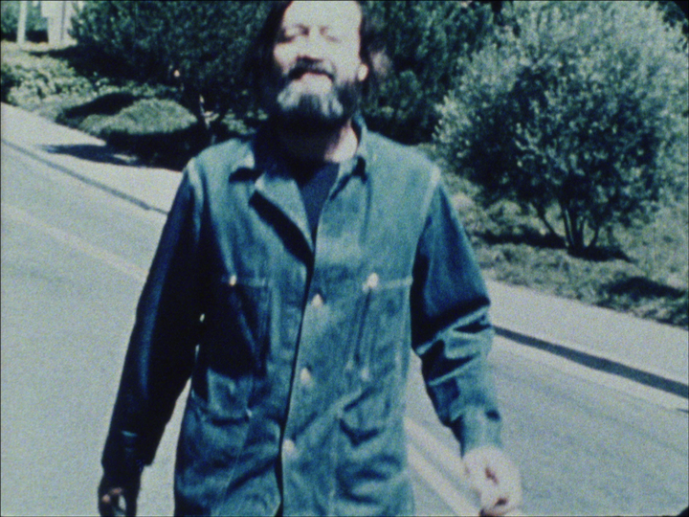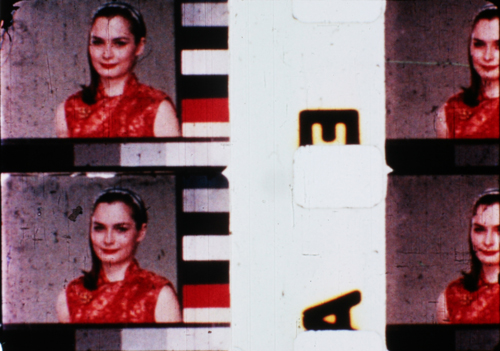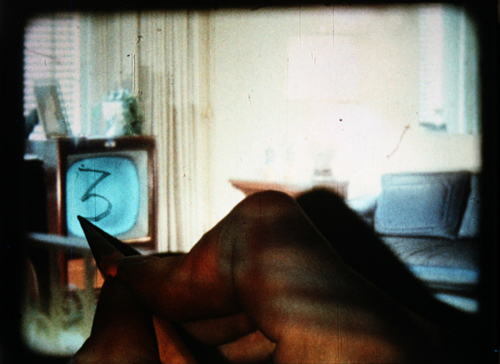Owen Land’s Strange, Expansive Film World

n
In 2011, when Owen Land died unexpectedly at the age of 67, an obituary writer for the Guardian, Ronald Bergan, noted that the former George Landow, who had changed his name semi-anagrammatically in 1977, had “rejected linear narrative, giving primacy to the shape and essence of film.”
That aligned him with other “structural” American directors in the 1960s and 1970s: film makers whose films were about the nature of film making.
Land said on one occasion that he “found the whole traditional narrative approach was really non-visual.” He may have been harking to a direction little taken, at the beginning of the film era: one in which narrative was not the be-all and end-all of film as a visual medium.
Land’s thinking was on show early in his career with his curious Film in Which There Appear Sprocket Holes, Edge Lettering, Dirt Particles, Etc., which consisted of four looped, identical, off-center images of a blinking woman taken from a Kodak color test, in all their dirty, scratched, and otherwise visually compromised state – at least, a state that film conventionally would consider impaired, but that Land made the actual subject of the four-minute, silent, 16mm film he created in 1965 and 1966.
It’s a film that is now one of three by Land that Anthology Film Archives will preserve with an award from the recently announced round of Avant-Garde Masters Grants from The Film Foundation and the National Film Preservation Foundation.
The eminent scholar of the American film avant-garde, P. Adams Sitney, claimed that Landow may have invented Structural Film with the seminal Film in Which There Appear Sprocket Holes, Edge Lettering, Dirt Particles, Etc. For a variety of reasons, suggests John Klacsmann, an archivist at Anthology Film Archives, the film “should be of particular interest to film archivists.” First, “it prominently ‘features’ a familiar laboratory calibration test or ‘China Girl.’” The China Girl was a curious feature of film technology, almost an insider joke. From the days before color film until the early 1990s hundreds of anonymous women graced more motion-picture film reels than many stars. A few frames of their face were inserted into the leaders of film reels (the short lengths of film before and after the images of the motion picture) for the technical purposes of lab technicians and projectionists.
n

n
Land’s Film in Which There Appear Sprocket Holes, Edge Lettering, Dirt Particles, Etc. was, by his own reckoning, “the dirtiest film ever made.” That was a joking allusion to his foregrounding the “imperfections” of filmmaking, making them the subject of his work. It is, as notes for a 2007 Harvard Film Archive retrospective of Land’s career observed, “one of the earliest examples of the film material dictating the film content.”
That had implications for the film’s preservation. When it came time for John Klacsmann at Anthology Film Archives to instruct the lab to which he entrusted the work, he had to take an unusual approach: “I told them not to clean the film as they regularly would, or use the typical restoration methods (i.e. liquid gate printing) that would hide or remove any of these intentional ‘flaws.’”
He says: “Since the film is literally about the dirt, scratches, etc. in the film itself, the preservation instructions to the lab were as straightforward as it gets: simply strike a new negative.”
As quixotic as Film that Includes… was, and remains, the two other Owen Land films that Anthology will preserve with Avant-Garde Masters Grants are hardly less idiosyncratic. Institutional Quality, from 1969, is “an apparent satire of traditional educational films,” says Klacsmann. The notes from that Harvard Film Archive retrospective explain that the 16mm, color, 5-minute piece is “constructed around a found soundtrack in which a strict female voice delivers a test of perception and comprehension,” and the film’s “sound and image relationship become detached as the filmmaker loses interest in his subject.
Klacsmann notes that Institutional Quality should not be confused with the more well-known New Improved Institutional Quality: In The Environment Of Liquids And Nasals A Parasitic Vowel Sometimes Develops (1976), a later “remake” utilizing the same soundtrack but completely different picture. Rather, Institutional Quality is an earlier film that Land (then, still named Landow) removed from distribution when he released New Improved. That, says Klacsmann, made Institutional Quality prints rarer, and the film became less known, “and in particular need of preservation.”
Klacsmann says Anthology selected Institutional Quality for its Essential Cinema repertory, rather than New Improved, which was released after the Essential Cinema selection had been completed. “Now that the film has finally been preserved, we will be able to introduce a new print of Institutional Quality into our Essential Cinema cycle.” That is a selection of 110 programs/330 titles that Anthology’s Film Selection Committee made in 1970-75 and that it shows in repertory format.
n

Institutional Quality
n
A Film of Their 1973 Spring Tour Commissioned by Christian World Liberation Front of Berkeley, CA (1974) is a commissioned documentary Landow shot during a three-month touring series of lectures and seminars by Jack Sparks, the leader of a Berkeley-based group of “radical counter-culture Christians.” The film, shot during Landow’s own “born again” period, was originally titled Thank You Jesus For The Eternal Present, Part 2. Klacsmann says that while it is one of Landow’s lesser-known works, it “was nonetheless selected for inclusion in the Essential Cinema under the original title.” Anthology never had a print, but did have Landow’s original reversal master, so now that we’ve preserved the film we can finally screen it as part of our regular Landow Essential Cinema program, albeit 40 years after it was selected.”
When Light Industry, a Brooklyn film and electronic-art venue, screened the film in 2015, its film notes said Land’s religious conversion had made him sympathetic to the aims of the group, but still he was surprised to get the commission. Perhaps, said the notes, that is why he made “a remarkable and extremely idiosyncratic record of the hippie proselytizers. Land took the fly-on-the-wall footage he shot of CWLF’s ‘73 tour and dramatically altered it through stroboscopic cross-cutting, rapidly alternating between shots in units only three-frames long.” Land told curator Mark Webber in 2004 that he had edited it “to maximize the amount of information on the screen at any given time.”
Light Industry said Land explained this by saying: “I didn’t think the specifics of what was being said (a) was that important in the hierarchy of what I was presenting, and (b) that it would even be possible to cover it all without making an extremely long, talking film.”
In that way, said Light Industry, Land was “an invited guest who articulated his milieu through a radical subjectivity. The stuttering phonemes and throbbing afterimages of his film transform an ordinary portrait of religiosity, conveying not merely an image of congregation, but the spirit that animates it.”
Of the three films covered by the NFPF grants, Klacsmann says: “Luckily, these three preservations were done from 16mm reversal camera originals and masters, all of which were in relatively good shape, not from print materials.” Anthology has held materials on all of Land’s films; nine of his films are in Anthology’s Essential Cinema repertory cycle.
The preservation process entailed having Colorlab in Maryland make new polyester negatives of all three titles; those color-corrected, sound-synced negatives, called “internegatives,” served to make answer prints and release prints. Says Klacsman: “We will exhibit the new prints at least once a calendar year at Anthology as part of George Landow’s Essential Cinema program and the prints will be available for loan under our normal procedures.”
Correction: The wording of the final paragraph has been updated to clarify the print-preparation process.
– Peter Monaghan
Previous Post: Disaster-Porn Shock Horror: Gertie the Galloping Bridge Really Just Lolloped
Next Post: Robert Altman's Compelling Early Cornball, Preserved





